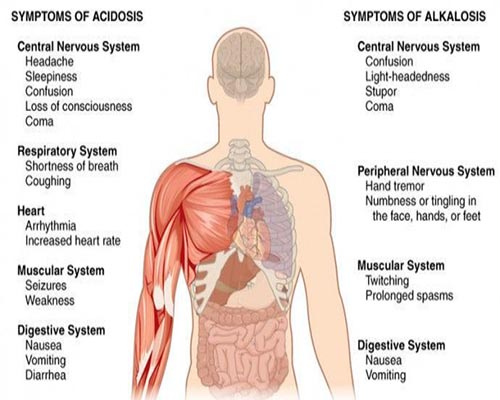This guest post was written Elisha of My Health Maven. She is deeply passionate about educating people and empowering them to lead healthier lives. I encourage you to check out her blog.
Acidic bodies are unhealthy bodies. When the body is acidic, it creates an unwanted environment where illness, bacteria, and yeast thrive. When the body is overly acidic, the body takes minerals from vital organs and bones to neutralize the acid and remove it from the body. Because of this, the body’s mineral reserves such as calcium, sodium, potassium and magnesium can run dangerously low and cause damage that can go undetected for years, until it reaches unhealthy levels, causing acidosis.
Most of us are already consuming enough acid forming foods, such as dairy, grains, meats and sugar. Since the body is constantly generating acidic waste products from the metabolism, those waste products need to be neutralized or excreted in some way. In order to neutralize the constant acid generation, we need to supply the body with more alkaline foods.
Consider the health problems caused by mild acidosis (poor pH balance):
- Inflamed sensitive gums, cavities
•Immune deficiency
•Sciatica, lumbago, stiff neck
•Respiratory problems, shortness of breath, coughing
•Yeast fungal overgrowth
•Low energy and chronic fatigue
•Cardiovascular damage, including the constriction of blood vessels and reduction in oxygen
•Heart problems, arrhythmias, increased heart rate
•Weight gain, obesity and diabetes
•Bladder and kidney infections
•Accelerated free radical damage
•Premature aging
•Nausea, vomiting, diarrhea
•Osteoporosis, weak brittle bones, hip fractures, bone spurs
•Headaches, confusion, sleepiness
•Joint pain, aching muscles and lactic acid buildup
•Allergies, acne
Doesn’t the body adjust pH on its own?
Yes it can, but it does so at a price. The normal pH for all tissues and fluids in the body,except the stomach is alkaline. With the exception of blood, all of the body systems have a wide pH range, in part so they can shift to maintain the blood pH, which must be maintained at the very narrow margin of 7.35 to 7.45. For example, if the system becomes too acidic, the blood will take alkaline forming elements from the digestive enzyme system of the small intestine. This now creates a less than optimal environment for proper digestion. So while the body can adjust pH on its own, it does so at a price to other systems in the body, which can lead to additional health problems.
Start by knowing your pH
pH testing is important because it allows an individual to get a numeric representation of the current level of acidification in their body. A healthy average pH reading will range anywhere from 6.75 to 7.25. The optimal pH numeric reading is 7.36. To learn more about ph testing check references at end of article.
You can’t tell if food is acidic or alkaline by taste alone
For example, many people think of lemons as acidic, while it is classified as an acidic fruit, it is actually an alkaline forming food. During the process of digestion the acids are oxidized into carbon dioxide and water, therefore they do not create an acid condition in the system.
Calcium, iron, magnesium, potassium and sodium are the main alkalizing minerals. Foods that are high in this minerals are considered alkaline forming food. Most foods have both acid and alkaline minerals in them. If acidic minerals are greater in concentration than that food is considered acidic and vice versa.
The body has limits
The body has limits for how much it can compensate for acid imbalance. Therefore food intake plays a critical role in maintaining the acid-alkaline balance. Many diseases and general malaise are the result of the body’s attempt to rebalance the internal environment.
Generally speaking, if the diet includes too many acid forming foods, such as high amounts of meats, grains, dairy, sugars, the body becomes more acidic. If you eat too many alkaline producing foods such as greens, fruits, sea vegetables the body can become too alkaline. Balance is key.
How does your body respond to specific foods?
It’s important to realize that the way your body responds to various foods depends on your dominant constitutional type. If your dominant type is oxidative then fruits and vegetables move the body to the more acid side, while proteins make your body more alkaline. If however you are more dominant to the autonomic system (ANS) then proteins cause your body to become more acidic and fruits and vegetables shift the body to a more alkaline environment.

How to improve your alkalinity
2. Drink plenty of water (alkaline water when possible)
3. Remove acidic foods
4. Replace a traditional lunch with a large green salad.
5. Use lettuce leaves and collard greens as wraps.
6. Try not to consume processed foods
7. Eliminate soda, sugars and coffee. Replace them with herbal tea, herbal coffee and green drinks
8. Replace dairy milks with coconut or almond milk
9. Add green juices or smoothies to your diet
What you eat matters
Improving pH levels may require a little more thought, but you’ll appreciate the rewards of your efforts as you begin to feel more energetic and vibrant and your overall health improves.
There is no question about it, what you eat has a direct impact on your overall health. It was Ann Wigmore, founder of the renowned Hippocrates Health Institute who said, “The food you eat can be either be the safest and most powerful form of medicine or the slowest form of poison.”
Taken from – https://greaterwellbe1ng.wordpress.com/2016/02/09/17-signs-your-body-is-too-acidic-and-9-ways-to-quickly-alkalize-it/ – 03/07/2016
By Elisha of My Health Maven









